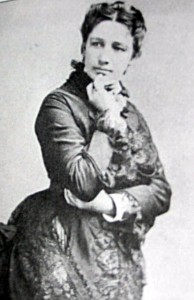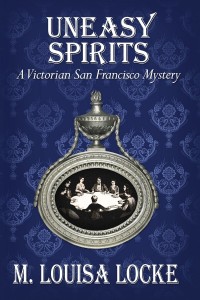 Relevant History welcomes M. Louisa Locke, a retired U.S history professor, who has recently published the first two books in a series about Victorian San Francisco, Maids of Misfortune and Uneasy Spirits, both best-selling historical mysteries on Kindle. Locke blogs frequently on self-publishing, is a featured contributor to Publetariat, and is on the Board of Directors of the Historical Fiction Authors Cooperative. She lives in San Diego with her husband, a dog and two cats, and she is working the third book in her series, Bloody Lessons. You can find more about her work on her website and follow her on Twitter and Facebook.
Relevant History welcomes M. Louisa Locke, a retired U.S history professor, who has recently published the first two books in a series about Victorian San Francisco, Maids of Misfortune and Uneasy Spirits, both best-selling historical mysteries on Kindle. Locke blogs frequently on self-publishing, is a featured contributor to Publetariat, and is on the Board of Directors of the Historical Fiction Authors Cooperative. She lives in San Diego with her husband, a dog and two cats, and she is working the third book in her series, Bloody Lessons. You can find more about her work on her website and follow her on Twitter and Facebook.
 On February 5, 1870, Victoria Woodhall and her sister Tennessee Claflin opened a brokerage firm, becoming the first women to trade on the New York Stock Exchange. These two women, who had spent their youth traveling around the country as Spiritualists and clairvoyants, had achieved this remarkable position (that would not be duplicated by any other women for nearly a century) by convincing the banking and railroad millionaire, Cornelius Vanderbilt, that the financial advice they had given him came from their contacts with the spirit world. After this advice helped him recover from the loss of millions in a bruising fight over control of the Erie Railroad, Vanderbilt, in turn, provided the necessary backing for them to open their brokerage firm. With the money she made on Wall Street, Victoria Woodhull then founded the newspaper, Woodhull and Claflin’s Weekly, from which she launched her reformist career, including her support for women’s suffrage, marriage reform, birth control, and the eight-hour day. In 1872 Woodhull went on to run for President of the United States for the newly formed Equal Rights Party.
On February 5, 1870, Victoria Woodhall and her sister Tennessee Claflin opened a brokerage firm, becoming the first women to trade on the New York Stock Exchange. These two women, who had spent their youth traveling around the country as Spiritualists and clairvoyants, had achieved this remarkable position (that would not be duplicated by any other women for nearly a century) by convincing the banking and railroad millionaire, Cornelius Vanderbilt, that the financial advice they had given him came from their contacts with the spirit world. After this advice helped him recover from the loss of millions in a bruising fight over control of the Erie Railroad, Vanderbilt, in turn, provided the necessary backing for them to open their brokerage firm. With the money she made on Wall Street, Victoria Woodhull then founded the newspaper, Woodhull and Claflin’s Weekly, from which she launched her reformist career, including her support for women’s suffrage, marriage reform, birth control, and the eight-hour day. In 1872 Woodhull went on to run for President of the United States for the newly formed Equal Rights Party.
While Victoria Woodhull was a highly unusual individual, the way in which she used Spiritualism to justify entering into economic and political realms that were well outside the accepted domestic boundaries of American womanhood was anything but unique.
Spiritualism, as a religious movement, took off in the United States in 1848 when the young Fox sisters began to communicate with the dead through a series of mysterious rapping sounds. Spiritualists believed in universal salvation and that spirits could communicate with the living. Mediums began to appear throughout the United States, and they professed to have the ability to speak with the dead through a variety of mechanisms, including spirit guides, celestial music, alphabetical codes, and slate writing. These mediums went into trances and spoke before large audiences in public halls, and they held seances and private “sittings” where the spirits gave advice and foretold the future.
The persistently high death rate among children in the nineteenth century and the devastating loss of life during the American Civil War did much to make Spiritualism attractive to members of the American public. Spiritualists assured them that their loved ones were not doomed to the eternal damnation of a Calvinist hell and provided the solace of continuing contact. In addition, the apparent parallels between the new scientific discoveries of electricity, magnetism, and long distance communication and the claims by mediums that they could use a “spiritual telegraph” or “magnetic healing powers” permitted Spiritualists to feel they were embracing a more modern form of religious belief.
Women found Spiritualism a particularly welcoming movement. Based on the belief that the individual could communicate directly with the divine through spirits, Spiritualism challenged the authority of established churches and permitted women an unprecedented degree of power. As Spiritualists, women spoke in public, formed and led organizations, wrote newspaper articles, and made money as mediums.
I first learned of the role Spiritualism played in women’s lives while I was doing research on women who worked in the cities of San Francisco, Portland, and Los Angeles at the end of the 19th century. I kept finding women who listed their occupation in the 1880 manuscript census as “clairvoyant” or “trance medium.” Then I found that women listing these occupations dominated the personal advertisements in local papers like the San Francisco Chronicle.
Take for example, the following advertisement: “Mrs. Crindle, Physical and Test Medium, 681 Mission. Correct information on stocks. Circles Friday, Sunday, Tuesday, 50c. Sittings, $1.”—San Francisco Chronicle, 1879.
As an ordinary woman, without the backing of a man like Vanderbilt, Mrs. Crindle would never have been able to join a brokerage firm. However, as a medium she could give financial advice, based not on her expertise and experience but on her supposed psychic ability to communicate with the spirit world.
Another example can be found in the way in which women used their purported abilities as mediums to practice medicine at a time when male doctors were challenging the traditionally female job of midwife. Spiritualists helped found the Woman’s Medical College of Philadelphia in 1850 (the first in the nation), and you can frequently find advertisements like: “Mme. C. Antonin M. D. Medium. Medical, also languages; correct diagnosis and successful treatment of all chronic and female diseases; consultation in English, French or German.”––San Francisco Chronicle, 1879.
Not surprisingly, when I began to cast around for a profession for Annie Fuller, the female sleuth in my Victorian San Francisco Mystery series, I thought of women like Mrs. Crindle and Madam Antonin. I had already decided to make Mrs. Fuller, a young widow, a boarding house keeper, the primary job held by married or widowed women in 1879 San Francisco. However, I also wanted her to have a job that would bring her into contact with possible criminal activities. So, I had her supplement her income as a clairvoyant, Madam Sibyl, who gives both business and domestic advice. Here was an occupation dominated by women that paid a decent wage, would bring her into contact with both men and women, and would give her a degree of personal autonomy.
It is the death of one of Madam Sibyl’s clients that precipitates Annie Fuller into her first murder investigation in Maids of Misfortune. And, in the sequel, Uneasy Spirits, it is Annie Fuller’s experiences as Madam Sibyl that prompt one of her boarders to ask for her help in exposing a fraudulent trance medium.
As to its relevance to the present, whether fictional T.V. characters on shows like the Ghost Whisperer or Medium, or in real life, women still dominate the profession of psychics. They still offer to contact loved ones and provide business advice and healing, and they often claim the ability to solve crimes. And, much to my amusement, I found that a real psychic now works next door to where my fictional Madam Sibyl lived in 1879 San Francisco!
*****
 A big thanks to M. Louisa Locke. She’ll give away an ebook copy or a print copy of Uneasy Spirits to two people who contribute comments on my blog this week. I’ll choose the two winners from among those who comment by Sunday at 6 p.m. ET.
A big thanks to M. Louisa Locke. She’ll give away an ebook copy or a print copy of Uneasy Spirits to two people who contribute comments on my blog this week. I’ll choose the two winners from among those who comment by Sunday at 6 p.m. ET.
**********
Did you like what you read? Learn about downloads, discounts, and special offers from Relevant History authors and Suzanne Adair. Subscribe to Suzanne’s free newsletter.

Among the books I borrowed from my mother, one of her father’s, was “The Widow’s Mite … .” Not Trollope’s, but maybe Dr. Isaac K. Funk’s. Alas, it did not win out over Dr. Zhivago (I WAS in my 20s), but I wish I had read it more carefully.
Excellent post! The Spiritualism movement is so fascinating to read about.
I was particularly taken with an aspect of this movement that had not occurred to me until I read your blog posting. It was how this was a viable option for women who needed to support themselves and it was a good choice for a woman who wished to be independent as well.
Enjoyed the post, thanks.
Totally enjoyed this post! I wasn’t aware of Ms. Woodhall’s Spiritualist background, but I will certainly read more about the entire movement now–it seems we as women have always had to enter certain professions through the back door, and I now have much more respect for the ways 19th century women marketed their business skills. Thank you for sharing this info; I look forward to Maids of Misfortune (it’s on my Kindle now).
Thanks for commenting, folks! I’ve had some technical difficulties and hope things are fixed now. What I find such fun about the Spiritualism movement is that it’s another example of women using their innate abilities to pioneer in an area they recognized was lucrative.
I’ve been researching more recent ghosts lately, and this post gives an historidal background for some things I’ve read. (Also gives me ideas!) Great post.
It’s a fun topic, isn’t it, Norma?
Thanks for all your comments. Having grown up in post WWII period, with the limited opportunities for women, I was continually surprised and often delighted when I learned about the roles that women played in society in earlier eras. It was also chastening to realize that some of the strides women made at the end of the 19th century, for example, entering into the medical and legal professions, had been lost by the 1950s and had to be fought for all over again.
M. Louisa
One thing I find interesting is the way some readers presume that women in all historical eras had the same societal roles and restrictions as women in the 1950s. High school history class is often (sadly) the only source of knowledge about history for many people in the U.S. If the class doesn’t mention the varying roles of women in history, it’s easy to superimpose “June Cleaver” onto women of all eras.
Victoria Woodhull was an amazing woman. I enjoyed writing a paper on her life for a college history class. I was supposed to do a paper about the Erie Railroad, but I was so thrilled to go off on the tangent to learn about her, I had to change my topic. Because of her I took a woman’s history class and added many other women (esp. Alice Paul) to my list of heroes.